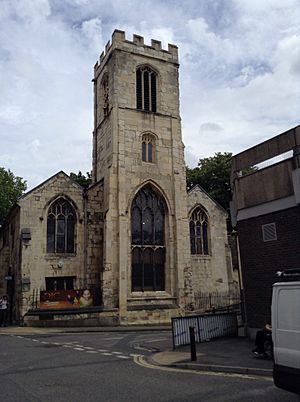St Saviour's Church, York facts for kids
Quick facts for kids St Saviour's Church, St Savioursgate, York |
|
|---|---|

The church in 2014
|
|
| 53°57′34.41″N 1°4′41.1″W / 53.9595583°N 1.078083°W | |
| Location | York |
| Country | England |
| Previous denomination | Church of England |
| History | |
| Dedication | St Saviour |
| Architecture | |
| Heritage designation | Grade II* listed |
| Closed | 1954 |
St Saviour's Church is a very old building in York, England. It is located on St Saviourgate. People also called it St Saviour in the Marsh. This church used to be a parish church for the Church of England. Today, it is a special historic building, known as a Grade II* listed site. This means it is very important and protected.
Contents
History of St Saviour's Church
Early Beginnings and Changes
St Saviour's Church was first built a very long time ago, in the 11th century. That's over 900 years ago! The building you see today was mostly built in the 15th century.
In 1586, some smaller church areas, called parishes, joined with St Saviour's. These were St John, Hungate, and St Andrew, St Andrewgate.
Building Improvements in the 1800s
The church had some big changes in the 1800s. Between 1844 and 1845, the sides of the church, called the north and south aisles, were rebuilt. This work was done by an architect named Richard Hey Sharp.
More improvements happened in 1871. The roofs were painted with bright colors like blue, crimson, and gold. The wooden benches (pews) and a special balcony (west gallery) were cleaned and polished. A new decorative screen, called a reredos, was added behind the altar. Fancy brass lights were hung, and the stone pillars were cleaned.
In 1878, a new room for the clergy, called a vestry, was added on the south side. Walter Green Penty designed this new room.
What Happened to the Church Later
St Saviour's Church stopped being a regular church in 1954. Its parish then joined with All Saints’ Pavement.
Today, the building is used by the York Archaeological Trust. This group studies old things and history in York. They use the old church for their important work.
The Church Organ
Organs Through the Years
A church organ is a large musical instrument that makes sound using air blown through pipes. St Saviour's Church had several organs over its history.
The first organ was put in by Mr. Ward of York in 1824. He also made it better in 1845. Later, in 1914, a new organ was installed by a company called Harrison and Harrison.
This 1914 organ was moved in 1952 to St Stephen's Church in Acomb. Sadly, that organ was later destroyed in a fire.
Famous Organist
A talented musician named Thomas Hopkins played the organ at St Saviour's Church for many years. He started in the 1860s and played until he passed away in 1893. Thomas Hopkins was the brother of another famous organist, Edward John Hopkins.

